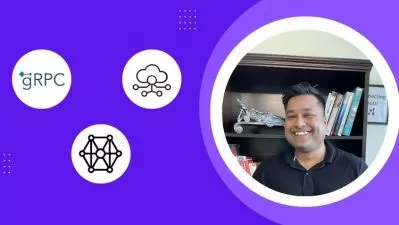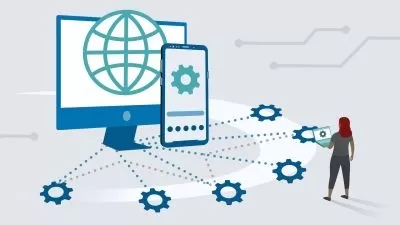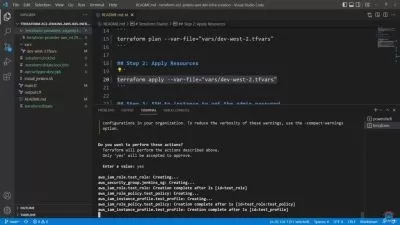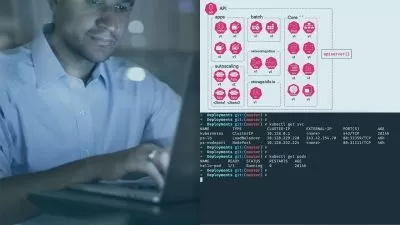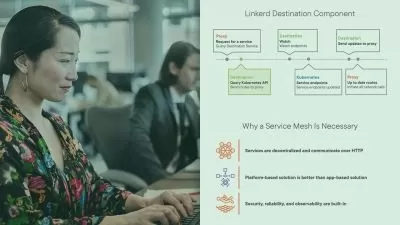Deploying Microservices to Kubernetes and AKS
Rahul Sahay
3:26:26
Description
Complete guide to build enterprise edition application end to end
What You'll Learn?
- Learn how to deploy your Microservices to Containers
- Learn how to deploy your Microservices to Kubernetes
- Learn how to apply different deployment model
- Learn how to create helm charts for different services
- Learn how to stitch all helm templates together
- Learn how to create Azure Kubernetes Service (AKS)
- Learn how to create Azure Container Registry (ACR)
- Learn how to push images to ACR
- Learn how to deploy components on AKS
- Visualize Kubernetes components using Kubernetes Lens
- Learn how to implement service mesh using Istio
- Learn how to enable side car injection
- Learn how to enable Kiali Dashboard to monitor the logs
- Learn how to enable Grafana and Prometheus Dashboard
Who is this for?
More details
DescriptionWelcome to course "Deploying Microservices to Kubernetes and AKS". This course is designed to teach you the best practices for building microservices with .Net Core using the Clean Architecture pattern.
This course covers everything you need to know to get started with microservices development in .Net Core. I'll cover the basics of microservices, introduce you to the Clean Architecture pattern, and show you how to build microservices using .Net Core.
This course includes complete hands-on experience that will give you the practical experience you need to master microservices development. You'll learn how to create a project using the Clean Architecture pattern, how to implement Domain-Driven Design (DDD) principles, and how to build and deploy your microservices using Docker and Kubernetes.
By the end of the course, you'll be able to confidently build and deploy your own microservices using .Net Core and Clean Architecture. You'll have a deep understanding of the concepts behind microservices and Clean Architecture, and be able to apply them to real-world projects.
Whether you're a seasoned .Net developer or just starting out with microservices, this course is the perfect way to get started. Sign up today and start building your microservices with .Net Core and Clean Architecture!
Microservices are a design pattern in which applications are composed of independent modules that communicate with each other within well defined boundaries. This makes it easier to develop, test, and deploy isolated parts of your application. If you are coming on this course directly, I suggest follow the Learning path as mentioned below to understand the entire picture.
Disclaimer:- Assuming you have already completed the prerequisite courses listed below in bold letters, as this course cannot be taken as a stand-alone course. Without the foundational knowledge and skills provided in those courses, you may struggle with understanding the API setup and overall flow of the course.
1. Getting Started with Microservices using Clean Architecture
2. Securing Microservices using Identity Server 4
3. Implementing Cross Cutting Concerns
4. Versioning Microservices
5. Building Angular Application for MicroServices
6. Deploying Microservices to Kubernetes and AKS (Current Course)
In the earlier section, you would have already learnt plethora of technologies while designing Microservices and implementing Identity Server. During that learning journey you must have designed Microservices module using clean architecture. In this section, you will learn plethora of techniques to host the solution on bare metal machine and on cloud as well. In this case, we will be hosting these containers first on local kubernetes cluster and then on the Azure Kubernetes Service (AKS). During this journey, we will also see how to write simple plain yaml files with variety of configurations and then how to deploy the same. Then, we will see how Helm Templates, enhances the reusability of this entire deployment module by reducing the noise of maintenance of multiple Yaml files of different services altogether. Finally, we will be enabling Service Mesh using Istio, where in you will how to enable side car patterns to enhance the monitoring of our pods.
This course is part of Microservices series where in you will learn all minute details related to Microservices. During this learning path, you will learn how to connect the dots using different technologies and tooling. This course "Deploying Microservices to Kubernetes and AKS" is the sixth edition of the series. In this course, you will be implementing following things:
Introduction
Introduction
Architectural Overview
Branching Strategy
Going back in time
K8s Architecture
What K8s can do
Kubernetes Setup
Enabling Kubernetes
K8s Components
Creating Catalog Api Yaml
Adding Brands and Types sections
Creating Mongo ConfigMap
Catalog Db Yaml Creation
Catalog db Secret Creation
Docker tag Catalog Api image
Catalog Api and Db Created
Setting up Kubernetes Dashboard
Fixing Container config issue
Kubernetes Lens
Fixing Checkout Issue
Azure Setup
Azure Container Registry setup
Docker ACR Tagging
Pushing Images to ACR
Creating Azure Container Registry Secret
AKS Creation Error
Fixing AKS Creation Issue
Merging AKS Credentials with local Kube Config
Helm Installation
Introduction
Helm Installation
Understanding Catalog Helm Template
Understanding Basket Helm Template
Understanding Discount Helm Template
Understanding Ordering Helm Template
Understanding Infrastructure Helm Templates
Understanding Powershell Script to install and uninstall components
Helm Installation Image Pull Issue
Fixing Azure Login server issue
Ocelot Issue
Enabling Service Mesh using Istio
Introduction
Istio features
Enabling Istio
Verifying Istio in Kube Lens
Disabling Sidecar injection
Enabling Kiali Dashboard
Visualizing Catalog pod traffic
Visualizing Grafana and Prometheus Dashboard
Thank You
Thank You
Who this course is for:
- Anyone who wants to learn Microservices end to end and learn how to apply each and every bit part by part.
Welcome to course "Deploying Microservices to Kubernetes and AKS". This course is designed to teach you the best practices for building microservices with .Net Core using the Clean Architecture pattern.
This course covers everything you need to know to get started with microservices development in .Net Core. I'll cover the basics of microservices, introduce you to the Clean Architecture pattern, and show you how to build microservices using .Net Core.
This course includes complete hands-on experience that will give you the practical experience you need to master microservices development. You'll learn how to create a project using the Clean Architecture pattern, how to implement Domain-Driven Design (DDD) principles, and how to build and deploy your microservices using Docker and Kubernetes.
By the end of the course, you'll be able to confidently build and deploy your own microservices using .Net Core and Clean Architecture. You'll have a deep understanding of the concepts behind microservices and Clean Architecture, and be able to apply them to real-world projects.
Whether you're a seasoned .Net developer or just starting out with microservices, this course is the perfect way to get started. Sign up today and start building your microservices with .Net Core and Clean Architecture!
Microservices are a design pattern in which applications are composed of independent modules that communicate with each other within well defined boundaries. This makes it easier to develop, test, and deploy isolated parts of your application. If you are coming on this course directly, I suggest follow the Learning path as mentioned below to understand the entire picture.
Disclaimer:- Assuming you have already completed the prerequisite courses listed below in bold letters, as this course cannot be taken as a stand-alone course. Without the foundational knowledge and skills provided in those courses, you may struggle with understanding the API setup and overall flow of the course.
1. Getting Started with Microservices using Clean Architecture
2. Securing Microservices using Identity Server 4
3. Implementing Cross Cutting Concerns
4. Versioning Microservices
5. Building Angular Application for MicroServices
6. Deploying Microservices to Kubernetes and AKS (Current Course)
In the earlier section, you would have already learnt plethora of technologies while designing Microservices and implementing Identity Server. During that learning journey you must have designed Microservices module using clean architecture. In this section, you will learn plethora of techniques to host the solution on bare metal machine and on cloud as well. In this case, we will be hosting these containers first on local kubernetes cluster and then on the Azure Kubernetes Service (AKS). During this journey, we will also see how to write simple plain yaml files with variety of configurations and then how to deploy the same. Then, we will see how Helm Templates, enhances the reusability of this entire deployment module by reducing the noise of maintenance of multiple Yaml files of different services altogether. Finally, we will be enabling Service Mesh using Istio, where in you will how to enable side car patterns to enhance the monitoring of our pods.
This course is part of Microservices series where in you will learn all minute details related to Microservices. During this learning path, you will learn how to connect the dots using different technologies and tooling. This course "Deploying Microservices to Kubernetes and AKS" is the sixth edition of the series. In this course, you will be implementing following things:
Introduction
Introduction
Architectural Overview
Branching Strategy
Going back in time
K8s Architecture
What K8s can do
Kubernetes Setup
Enabling Kubernetes
K8s Components
Creating Catalog Api Yaml
Adding Brands and Types sections
Creating Mongo ConfigMap
Catalog Db Yaml Creation
Catalog db Secret Creation
Docker tag Catalog Api image
Catalog Api and Db Created
Setting up Kubernetes Dashboard
Fixing Container config issue
Kubernetes Lens
Fixing Checkout Issue
Azure Setup
Azure Container Registry setup
Docker ACR Tagging
Pushing Images to ACR
Creating Azure Container Registry Secret
AKS Creation Error
Fixing AKS Creation Issue
Merging AKS Credentials with local Kube Config
Helm Installation
Introduction
Helm Installation
Understanding Catalog Helm Template
Understanding Basket Helm Template
Understanding Discount Helm Template
Understanding Ordering Helm Template
Understanding Infrastructure Helm Templates
Understanding Powershell Script to install and uninstall components
Helm Installation Image Pull Issue
Fixing Azure Login server issue
Ocelot Issue
Enabling Service Mesh using Istio
Introduction
Istio features
Enabling Istio
Verifying Istio in Kube Lens
Disabling Sidecar injection
Enabling Kiali Dashboard
Visualizing Catalog pod traffic
Visualizing Grafana and Prometheus Dashboard
Thank You
Thank You
Who this course is for:
- Anyone who wants to learn Microservices end to end and learn how to apply each and every bit part by part.
User Reviews
Rating
Rahul Sahay
Instructor's Courses
Udemy
View courses Udemy- language english
- Training sessions 45
- duration 3:26:26
- Release Date 2023/04/26






